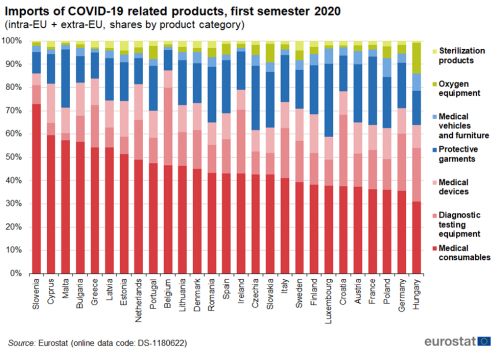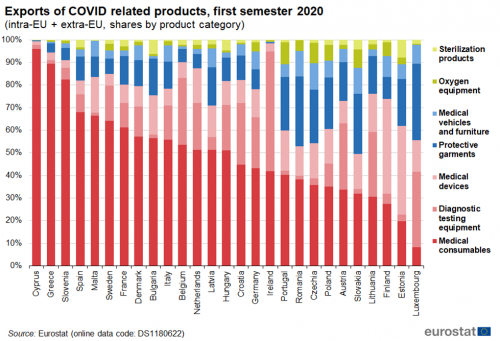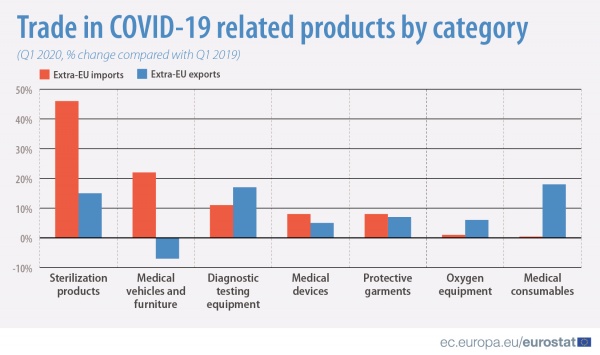Archive:EU trade in COVID-19 related products
Data extracted in September 2020.
No planned update.
Highlights
China, the United States and Switzerland were the largest trade partners for COVID-19 related products in the first semester of 2020.
Sharp increase of COVID-19 related extra-EU imports in April and May 2020, falling in June 2020.
To help prevent the spread of the COVID-19 pandemic, countries around the world have taken a variety of restrictive measures, which have negatively affected international trade in goods, with a few noteworthy exceptions. Among these are goods used in direct response to the COVID-19 pandemic: sterilisation products (incl. disinfectants), medical vehicles and furniture, protective garments, diagnostic testing equipment, medical devices, oxygen therapy equipment and medical consumables, or so called ‘COVID-19 related products’. In this article, imports and exports of these goods are presented by product group and compared over time with other similar products, across EU Member States and by main trade partner.
Full article
In March 2020, extra-EU imports of COVID-19 related products increased by 2 % compared with March 2019, in contrast to trade in other similar products [1], which fell by 5 %. Over the same period, extra-EU exports of COVID-19 related products increased by 18 %, while extra-EU exports of other similar products fell by 2 %. In April (+ 62 %), May (+ 78 %) and June (+ 53 %) imports of COVID-19 related products dramatically increased, due to a sharp rise in imports from China. Imports of related products in April and May decreased by 12 % and 13 % but was stable in June. Exports of COVID-19 related products rose most in February (+14 %) and March (+18 %) while exports of related products in these month disd not change much but decreased sharply in April and May (both - 26 %).

Source: Eurostat DS-1180622
Figure 2 compares the growth rates by product group for trade in COVID-19 related products between the first semester of 2019 and the first semester of 2020. The growth rates for imports were highest for protective garments (+ 187 %), sterilization products (+ 73 %) and oxygen equipment (+ 28 %). In exports, the growth rates were highest for sterilization products (+ 24 %), diagnostic testing equipment and medical consumables (both + 13 %).

Source: Eurostat DS-1180622
The three main trading partners for COVID-19 related products were the United States, China and Switzerland (Figure 3). The United States was the largest partner for exports while China was the largest partner for imports. The remainder of this paragraph focuses on these three partners.

Source: Eurostat DS-1180622
Throughout 2019, the United States was the largest partner for EU imports of COVID-19 related products, followed by Switzerland and China (Figure 4). However, in January 2020, imports from Switzerland experienced a strong growth and in the first quarter of 2020 they were the largest. In April, China overtook Switzerland and became the largest origin of EU imports. In large part, this was due to the import of protective garments from China.

Source: Eurostat DS-1180622
Throughout the whole period under consideration, the United States was the largest partner of COVID-19 related exports (Figure 5). Exports to the United States were very high in March 2020 when they also peaked for Switzerland. Exports to China peaked one month earlier in February 2020.

Source: Eurostat DS-1180622
For each of the three main partners, the leading product category for imports was different: medical consumables for imports originating from Switzerland; protective gear for imports from China; and diagnostic testing equipment for imports from the United States (Figure 6).

Source: Eurostat DS-1180622
There were more similarities in exports from the EU to its three main partners. In all cases, medical consumables was the leading product category (Figure 7). Diagnostic testing equipment was the second largest for exports to the United States and Switzerland, while for China medical devices was the second largest group.

Source: Eurostat DS-1180622
Per capita trade largest in Ireland, Belgium, the Netherlands and Slovenia
Figure 8 shows that per capita imports of COVID-19 related products were highest in Belgium (€ 1 943), the Netherlands (€ 1 325), Slovenia (€ 1 305) (see footnote 2) and Ireland (€ 991). These same four countries, but in a different order, also had the highest per capita exports. Ireland had by far the highest per capita values (€ 4 937), reflecting a high specialisation in the trading of these products, especially diagnostic test equipment and medical consumables. Ireland was followed by Belgium (€ 2 133), the Netherlands (€ 1 842) and Slovenia (€ 1 793). The lowest value for imports per capita were observed in Poland (€ 187), Greece (€ 184), Romania (€ 174) and Bulgaria (144 € ). The majority of countries (15 out of 27) recorded a per capita value between € 200 and € 500.

Source: Eurostat (proj_19np) and DS-1180622
The growth rates for trade of COVID-19 related products between the first semester of 2019 and the first semester of 2020 were highest in Slovenia, both for imports (59 %) and exports (63 %) (see footnote 2). For imports three other Member States had growth rates of more than 30 %, namely Hungary (38 %), Malta (35 %) and Luxembourg (32 %). In exports Greece (48 %), Sweden (32 %), Luxembourg and Cyprus (both 31 %) had growth rates higher than 30 %. There were no Member States where imports declined in the first semester of 2019. In contrast exports declined in Czechia (- 1 %), Italy, Slovakia (both - 2%), Malta (- 4 %), Latvia (- 9 %) and Croatia (- 10 %).

Source: Eurostat DS-1180622
Table 1 and 2 shows per capita imports and exports in the first semester of 2020. Belgium had the highest per capita value in imports of test equipment (€ 646), while in Malta, Cyprus and Bulgaria the value of imports was less than € 20 per capita. The variation in values between Member States (as measured by the relative standard deviation) was largest for diagnostic equipment. In contrast the variation in values between Member States was smallest in protective garments. Luxembourg had the highest values for protective garments (€ 248) and medical vehicles (€ 51). The Netherlands was the Member State with the highest values for sterilization products (€ 37) and medical devices (€ 204). Hungary had the highest value (€ 64) for oxygen therapy equipment. Slovenia[2] had the largest per capita value in medical consumables (almost € 952) , due to large imports of certain medical products from Switzerland.

Source: Eurostat (proj_19np) and DS-1180622
According to the relative standard deviation, the total export of COVID-19 related products showed a higher per capita variability with respect to the import values for all the groups, with the highest values for diagnostic test equipment. Ireland had by far the highest per capita exports in diagnostic test equipment (€ 2614) and medical consumables (€ 2070), while Romania was at the bottom of this ranking for the same products. Germany had the highest per capita values for the export of medical vehicles (€ 56). Belgium had the highest per capita values for protective garments (€ 124) and sterilisation products (€ 46), while the Netherlands was first for medical devices ( € 282). Cyprus recorded the lowest per capita values for protective garments, medical devices and vehicles, and it was co-sharing with Malta the lowest values for oxygen equipment and with Romania for sterilization products.

Source: Eurostat (proj_19np) and DS-1180622
Among all Member States, the most imported product group was medical consumables with the highest shares in Slovenia (73 %), Cyprus (59 %) and Malta (57 %) as shown in Figure 10. The shares for diagnostic equipment were highest in Belgium (33 %) and Croatia (31 %). Cyprus and Finland (both 17 %) had the highest share in medical devices. Luxembourg (31 %) had the highest shares in protective garments, partly through their nationwide distribution of face masks. Poland (8 %) had the highest share in medical vehicles and furniture. Hungary (13 %) had the highest share in oxygen therapy equipment and Estonia and Sweden (both 4 %) in sterilization products.

Source: Eurostat DS-1180622
In 23 Member States, the most exported product group was medical consumables with the highest shares in Cyprus (96 %) and Greece (89 %) as shown in Figure 11. The share for diagnostic equipment was highest in Ireland (53 %). Finland (42 %) and Estonia (39 %) had the highest shares in medical devices. Luxembourg (34 % and Romania (31 %) had the highest shares in protective garments. Czechia (12 %), Romania and Slovakia (both 11 %) had the highest shares in medical vehicles and furniture. Portugal (10 %) and Czechia (9 %) had the highest share in oxygen equipment and Estonia (8 %) in sterilization products.

Source: Eurostat DS-1180622
Germany was the largest importer of COVID-19 related products for both intra-EU and extra-EU imports (Figure 12). In all but four Member States (the Netherlands, Ireland, Slovenia and Malta) intra-EU imports were larger than extra-EU imports.

Source: Eurostat DS-1180622

Source: Eurostat DS-1180622
Footnote
- ↑ This graph compares COVID-19 related products with products in the same chapter of the Harmonised System (HS) product classification, i.e. they are compared with other similar products that are however not directly used in response to the COVID-19 pandemic.
It should be noted that most COVID-19 related products cannot be precisely identified and they are grouped together with products not specific to COVID-19. Nevertheless, some trends can be observed.
These products were selected based on an indicative list elaborated by the Commission in the framework of Commission Decision N° C(2020) 2146, on the basis of a joint WCO/WHO list for COVID-19 medical supplies. More information can be found in this document. - ↑ Large Slovenian pharmaceutical companies already started increased production for some of these products from January 2019 onwards which affected both imports and exports.
Source data for tables and graphs
Data sources
EU data is taken from Eurostat's COMEXT database. COMEXT is the reference database for international trade in goods. It provides access not only to both recent and historical data from the EU Member States but also to statistics of a significant number of third countries. International trade aggregated and detailed statistics disseminated via the Eurostat website are compiled from COMEXT data according to a monthly process.
Data are collected by the competent national authorities of the Member States and compiled according to a harmonised methodology established by EU regulations before transmission to Eurostat. For extra-EU trade, the statistical information is mainly provided by the traders on the basis of customs declarations.
EU data are compiled according to Community guidelines and may, therefore, differ from national data published by the Member States. Statistics on extra-EU trade are calculated as the sum of trade of each of the 27 EU Member States with countries outside the EU. In other words, the EU is considered as a single trading entity and trade flows are measured into and out of the area, but not within it.
The EU-27 data reflect the political change in the EU composition. Therefore, the United Kingdom is considered as an extra-EU partner country for the EU-27. However, the United Kingdom is still part of the internal market until the end of the transitory period, meaning that data on trade with the United Kingdom are still based on statistical concepts applicable to trade between the EU Member States. As a consequence, while imports from any other extra-EU-27 trade partner are grouped by country of origin, the United Kingdom data reflect country of consignment. In practice this means that the goods imported by the EU-27 from the United Kingdom were physically transported from the United Kingdom but part of these goods could have been of other origin than the United Kingdom. For this reason data on trade with the United Kingdom are not fully comparable with data on trade with other extra-EU-27 trade partners.
Methodology
In this article some products are classified as COVID-19 related products. They are compared over time and across countries, and also to products in the same chapter of the Harmonised System (HS) product classification, i.e. they are compared to other similar products that are however not directly used in response to the COVID-19 pandemic. It should be noted that most COVID-19 related products cannot be precisely identified and they are grouped together with products not specific to COVID-19. Nevertheless, some trends can be observed.
According to the EU concepts and definitions, extra-EU trade statistics (trade between EU Member States and non-EU countries) do not record exchanges involving goods in transit, placed in a customs warehouse or given temporary admission (for trade fairs, temporary exhibitions, tests, etc.). This is known as ‘special trade’. The partner is the country of final destination of the goods for exports and the country of origin for imports.
Product classification
The COIVID-19 products in this article were selected based on an indicative list elaborated by the Commission in the framework of Commission Decision N° C(2020) 2146, on the basis of a joint WCO/WHO list for COVID-19 medical supplies. More information can be found in this document.
Unit of measure
Trade values are expressed in millions or billions (109) of euros. They correspond to the statistical value, i.e. to the amount which would be invoiced in the event of sale or purchase at the national border of the reporting country. It is called a FOB value (free on board) for exports and a CIF value (cost, insurance, freight) for imports.
Context
Trade is an important indicator of Europe’s prosperity and place in the world. The bloc is deeply integrated into global markets both for the products it sources and the exports it sells. The EU trade policy is an important element of the external dimension of the ‘Europe 2020 strategy for smart, sustainable and inclusive growth’ and is one of the main pillars of the EU’s relations with the rest of the world.
Because the 27 EU Member States share a single market and a single external border, they also have a single trade policy. EU Member States speak and negotiate collectively, both in the World Trade Organization, where the rules of international trade are agreed and enforced, and with individual trading partners. This common policy enables them to speak with one voice in trade negotiations, maximising their impact in such negotiations. This is even more important in a globalised world in which economies tend to cluster together in regional groups.
The openness of the EU’s trade regime has meant that the EU is the biggest player on the global trading scene and remains a good region to do business with. Thanks to the ease of modern transport and communications, it is now easier to produce, buy and sell goods around the world which gives European companies of every size the potential to trade outside Europe.
Direct access to
- International trade in goods (t_ext_go), see:
- International trade in goods - long-term indicators (t_ext_go_lti)
- International trade in goods - short-term indicators (t_ext_go_sti)
- International trade in goods (ext_go), see:
- International trade in goods - aggregated data (ext_go_agg)
- International trade in goods - long-term indicators (ext_go_lti)
- International trade in goods - short-term indicators (ext_go_sti)
- International trade in goods - detailed data (detail)
- EU trade since 1988 by SITC (DS-018995)
- International trade in goods statistics - background
- International trade in goods (ESMS metadata file — ext_go_esms)
- User guide on European statistics on international trade in goods
